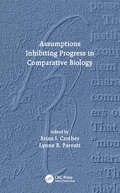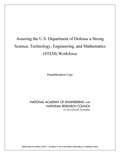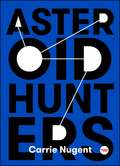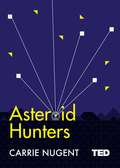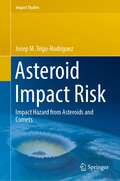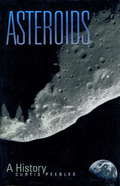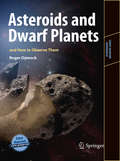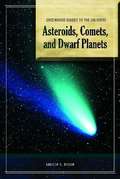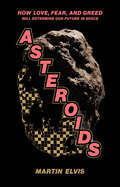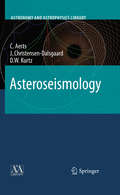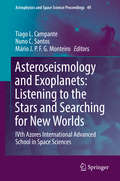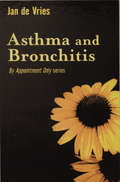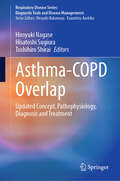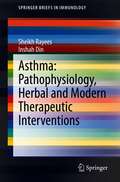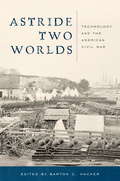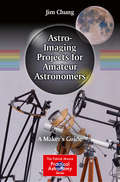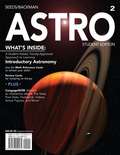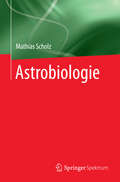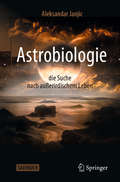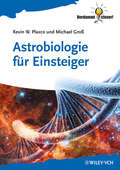- Table View
- List View
Assumptions Inhibiting Progress in Comparative Biology
by Brian I. Crother & Lynne R. ParentiThis book is a thought-provoking assessment of assumptions inhibiting progress in comparative biology. The volume is inspired by a list generated years earlier by Donn Rosen, one of the most influential, innovative and productive comparative biologists of the latter 20th century. His list has assumed almost legendary status among comparative evolutionary biologists. Surprisingly many of the obstructing assumptions implicated by Rosen remain relevant today. Any comparative biologist hoping to avoid such assumptions in their own research will benefit from this introspective volume.
Assuring the U.S. Department of Defense a Strong Science, Technology, Engineering, and Mathematics (STEM) Workforce
by National Research Council National Academy of Engineering Division on Engineering and Physical Sciences Policy and Global Affairs Board on Higher Education and Workforce Committee on Science, Technology, Engineering, and Mathematics Workforce Needs for the U.S. Department of Defense and the U.S. Defense Industrial BaseThe ability of the nation's military to prevail during future conflicts, and to fulfill its humanitarian and other missions, depends on continued advances in the nation's technology base. A workforce with robust Science, Technology, Engineering and Mathematics (STEM) capabilities is critical to sustaining U.S. preeminence. Today, however, the STEM activities of the Department of Defense (DOD) are a small and diminishing part of the nation's overall science and engineering enterprise. Assuring the U.S. Department of Defense a Strong Science, Technology, Engineering, and Mathematics (STEM) Workforce presents five principal recommendations for attracting, retaining, and managing highly qualified STEM talent within the department based on an examination of the current STEM workforce of DOD and the defense industrial base. As outlined in the report, DOD should focus its investments to ensure that STEM competencies in all potentially critical, emerging topical areas are maintained at least at a basic level within the department and its industrial and university bases.
Asteroid Hunters (TED Books)
by Carrie NugentFor the first time, scientists could have the knowledge to prevent a natural disaster epic in scale—an asteroid hitting the earth and in this exciting, adventuresome book, Carrie Nugent explains how.What are asteroids, and where do they come from? And, most urgently: Are they going to hit the Earth? What would happen if one was on its way? Carrie Nugent is an asteroid hunter—part of a group of scientists working to map our cosmic neighborhood. For the first time ever, we are reaching the point where we may be able to prevent the horrible natural disaster that would result from an asteroid collision. In Asteroid Hunters, Nugent reveals what known impact asteroids have had: the extinction of the dinosaurs, the earth-sized hole Shoemaker Levy 9 left in Jupiter just a few decades ago, how the meteorite that bursted over Chelyabinsk in Russia could have started a war, and unlucky Ms. Anne Hodges—the only person (that we know of) in US history to be the victim of a direct hit. Nugent also introduces the telescope she uses to detect near-Earth asteroids. Ultimately, detection is the key to preventing asteroid impact, and these specialized scientists are working to prevent the unthinkable from happening. If successful, asteroid hunting will lead to the first natural disaster humans have the know-how and the technology to prevent. The successful hunt and mapping of asteroids could mean nothing less than saving life on earth.
Asteroid Hunters (Ted Bks.)
by Carrie NugentDr Carrie Nugent is an asteroid hunter - one of the select group of scientists working diligently to map our cosmic neighbourhood. For the first time ever we are reaching the point where we may be able to prevent a natural disaster resulting from an asteroid collision. Nugent will delve into the impact asteroids have had in the past: the extinction of the dinosaurs, the earth-sized hole Shoemaker-Levy 9 left in Jupiter just a few years ago, how the surprise hit on Chelyabinsk in Russia could have started a war and unlucky Ms Anne Hodges - the only person (that we know of) in modern history to be the victim of a direct hit. Nugent will also reveal the cutting-edge work that she is part of - using NASA's NEOWISE telescope to track down near-Earth asteroids. NEOWISE has seen over 158,000 asteroids and discovered over 30,000. We will also get a rare glimpse into the work of this band of asteroid hunters and their techniques. Asteroid orbits are chaotic which means a small early change has a big impact later on. The successful hunt and mapping of asteroids could mean nothing less than saving life on Earth.
Asteroid Impact Risk: Impact Hazard from Asteroids and Comets (Impact Studies)
by Josep M. Trigo-RodríguezThis book describes the complexity of impact hazards associated with asteroids and comets. The challenge in this regard lies in the heterogeneous nature of these bodies that endanger our planet, which is why we are conducting new experiments to better understand their unique physicochemical properties. Several generations of astronomers have tracked and mapped the orbits of asteroids and comets over the past few centuries, and telescopic surveys have only begun to discover “new” interstellar objects. In addition, cutting-edge software allow our computers to combine the orbits of these elusive bodies to study how they evolve over time and seek to match asteroid complexes as fragments of asteroidal and cometary disruptions.Impact hazards represent one of the greatest threats to the survival of human beings in the medium term. Geological studies show that the stratigraphic record holds clear geological evidence of these rare but transcendental encounters in the history of life on our planet. The study and quantification of past catastrophes can give us clues to face future challenges in the form of potential impacts.Further, it would be illogical to assume that Earth’s interaction with space is limited to major impacts. Every night, Earth is struck by millions of particles, and dozens of meteor showers occur around the globe every year. The study of lake and ocean sediments reveals the magnitude of the continuous contribution of interplanetary matter reaching Earth: roughly 100,000 tons per year.Accordingly, the goal of this book is to underscore the need for society-wide awareness of the dangers associated with asteroid and comet impacts, on the basis of scientific evidence and with no intention of sparking alarmism. After all, we ourselves may only be the fruit of an opportunity given to mammals sixty-five million years ago to evolve after the conflagration that would be the downfall of the dinosaurs. If we have learned to read Earth’s geological history, we should consider ourselves a very fortunate species, and its teachings should equip us to face this problem.The also book emphasizes the role of space missions to gain insights on these bodies, particularly describing the relevance of the DART (NASA) and Hera (ESA) missions to deflect and study Dimorphos, respectively, the small satellite of the Didymos binary asteroid.
Asteroid, Meteoroid, and Comet Facts (Into Reading, Level T #76)
by Bruce NaylorNIMAC-sourced textbook
Asteroids
by Curtis PeeblesAsteroids suggest images of a catastrophic impact with Earth, triggering infernos, tidal waves, famine, and death -- but these scenarios have obscured the larger story of how asteroids have been discovered and studied. During the past two centuries, the quest for knowledge about asteroids has involved eminent scientists and amateur astronomers, patient research and sudden intuition, advanced technology and the simplest of telescopes, newspaper headlines and Cold War secrets. Today, researchers have named and identified the mineral composition of these objects. They range in size from 33 feet to 580 miles wide and most are found in a belt between the orbits of Mars and Jupiter.Covering all aspects of asteroid investigation, Curtis Peebles shows how ideas about the orbiting boulders have evolved. He describes how such phenomena as the Moon's craters and dinosaur extinction were gradually, and by some scientists grudgingly, accepted as the results of asteroid impacts. He tells how a band of icy asteroids rimming the solar system, first proposed as a theory in the 1940s, was ignored for more than forty years until renewed interest and technological breakthroughs confirmed the existence of the Kuiper Belt. Peebles also chronicles the discovery of Shoemaker-Levy 9, a comet with twenty-two nuclei that crashed into Jupiter in 1994, releasing many times the energy of the world's nuclear arsenal.Showing how asteroid research is increasingly collaborative, the book provides insights into the evolution of scientific ideas and the ebb and flow of scientific debate.
Asteroids
by Michael K. ShepardWhere do asteroids come from and what are they made of? What clues do they hold about the evolution of the Solar System? Scientists have catalogued hundreds of thousands of asteroids, and many are thought to contain water and amino acids, the building blocks of life. Michael K. Shepard tells the fascinating story of their discovery, and what they can tell us about the history of our own planet. He describes how we find and study asteroids, what they look like through the eyes of powerful telescopes and spacecraft, and plans for future sample return missions. This timely book interweaves accessible scientific explanations with historical background and personal narrative, providing an engaging read for anyone curious about asteroids and what they may mean for our future - both as threats and opportunities.
Asteroids and Dwarf Planets and How to Observe Them (Astronomers' Observing Guides)
by Roger DymockDwarf planets (which were formerly called asteroids except for the planet Pluto), and the smaller Solar System bodies still called asteroids today, are making front page news, particularly those that are newly discovered and those that might present a hazard to life on Earth by impacting our planet. In this age of giant telescopes and space probes, these small Solar System bodies have advanced from being tiny points of light to bodies worthy of widespread study. This book describes the dwarf planets and asteroids themselves, their origins, orbits, and composition, and at how amateur astronomers can play a part in their detection, tracking, and imaging. The book is divided into two parts. Part I describes physical properties (including taxonomic types) of dwarf planets and asteroids, how they formed in the early life of the Solar System, and how they evolved to their present positions, groups, and families. It also covers the properties used to define these small Solar System bodies: magnitude, rotation rates (described by their light-curves), and orbital characteristics. Part II opens with a description of the hardware and software an amateur or practical astronomer needs to observe and also to image asteroids. Then numerous observing techniques are covered in depth. Finally, there are lists of relevant amateur and professional organizations and how to submit your own observations to them.
Asteroids, Comets, and Dwarf Planets
by Andrew Rivkin Andrew S. RivkinA working astronomer, Rivkin looks at the smallest bodies in the solar system, providing readers with the most current information about asteroids, comets, and dwarf planets (including Pluto). Written with students in mind, the book describes how such small bodies form, what they are made of, and what kind of atmospheres they might have. It also discusses whether any of these bodies--especially asteroids--present a danger to spacecraft or to the earth. Featuring many illustrations and an extensive glossary of astronomical terms, this lively book will interest almost anyone who wants to know more about the solar system. Annotation c2009 Book News, Inc., Portland, OR (booknews.com)
Asteroids: How Love, Fear, and Greed Will Determine Our Future in Space
by Martin ElvisA unique, wide-ranging examination of asteroid exploration and our future in space Human travel into space is an enormously expensive and unforgiving endeavor. So why go? In this accessible and authoritative book, astrophysicist Martin Elvis argues that the answer is asteroid exploration, for the strong motives of love, fear, and greed. Elvis’s personal motivation is one of scientific love—asteroid investigations may teach us about the composition of the solar system and the origins of life. A more compelling reason may be fear—of a dinosaur killer–sized asteroid hitting our planet. Finally, Elvis maintains, we should consider greed: asteroids likely hold vast riches, such as large platinum deposits, and mining them could provide both a new industry and a funding source for bolder space exploration. Elvis explains how each motive can be satisfied, and how they help one another. From the origins of life, to “space billiards,” and space sports, Elvis looks at how asteroids may be used in the not-so-distant future.
Asteroseismology
by Pere L. Pallé César EstebanOur understanding of stars has grown significantly due to recent advances in asteroseismology, the stellar analog of helioseismology, the study of the Sun's acoustic wave oscillations. Using ground-based and satellite observatories to measure the frequency spectra of starlight, researchers are able to probe beneath a star's surface and map its interior structure. This volume provides a wide-ranging and up-to-date overview of the theoretical, experimental and analytical tools for carrying out front-line research in stellar physics using asteroseismological observations, tools and inferences. Chapters from seven eminent scientists in residence at the twenty-second Canary Islands Winter School of Astrophysics examine the interior of our Sun relative to data collected from distant stars, how to measure the fundamental parameters of single field stars, diffusion processes, and the effects of rotation on stellar structures. The volume also provides detailed treatments of modeling and computing programs, providing astronomers and graduate students a practical, methods-based guide.
Asteroseismology (Astronomy and Astrophysics Library #162)
by D. W. Kurtz J. Christensen-Dalsgaard C. AertsThe recent research domain of asteroseismology studies the internal structure of stars, which is not directly observable, through the interpretation of the frequency spectra of stellar oscillations. The basic principles of asteroseismology are very similar to those developed by earth seismologists. Stellar interiors can be probed from oscillations because different oscillation modes penetrate to different depths inside the star. Asteroseismology is the only available method to derive the internal structure of the stars with high precision. This book - the first on asteroseismology - offers a practical guide for graduate students and scientists working in stellar astrophysics. It provides a general introduction to asteroseismology and comprehensive coverage of all its aspects: fundamental theory, observations and observational techniques, methodology of data analysis and seismic interpretations of various classes of multi-periodic pulsating stars.
Asteroseismology and Exoplanets: IVth Azores International Advanced School in Space Sciences (Astrophysics and Space Science Proceedings #49)
by Tiago L. Campante Nuno C. Santos Mário J. P. F. G. MonteiroThis book presents the proceedings of the IVth Azores International Advanced School in Space Sciences entitled "Asteroseismology and Exoplanets: Listening to the Stars and Searching for New Worlds". The school addressed the topics at the forefront of scientific research being conducted in the fields of asteroseismology and exoplanetary science, two fields of modern astrophysics that share many synergies and resources. These proceedings comprise the contributions from 18 invited lecturers, including both monographic presentations and a number of hands-on tutorials.
Asthma and Bronchitis
by Jan de VriesIt is clear that asthma and bronchitis are on the increase, especially in Britain, and there are strong indications that this rise may be linked to atmospheric influences. Jan de Vries has over 30 years' experience of treating these conditions and in this important title in the By Appointment Only series he sets out his own ideas about respiratory disorders. He shows, for example, how many allergic reactions can result in asthma-related problems, hay-fever being a case in point. Viruses, bacteria and irritants may result in dry coughs, mucus formation, breathlessness, muscle pain and even light fever, depression and sometimes emphysema. Emphysema is known to be incurable, but Jan de Vries shows his treatments can bring welcome relief.
Asthma-COPD Overlap: Updated Concept, Pathophysiology, Diagnosis and Treatment (Respiratory Disease Series: Diagnostic Tools and Disease Managements)
by Hiroyuki Nagase Hisatoshi Sugiura Toshihiro ShiraiThis book elucidates the diagnostic criteria and concept of asthma-COPD overlap (ACO) and provides the latest information on its epidemiology, pathophysiology, diagnostic criteria, and treatment options. It discusses the controversy-causing findings of prognosis of ACO, the novel molecular mechanism including nitrosative stress, radiological or physiological features, findings by research that used HRCT or forced oscillation technique. In addition to a recent animal model of ACO, the role of each biomarker, the latest results of ICS/LAMA/LABA combination inhalers or biologics is also debated. Asthma COPD Overlap -Updated Concept, Pathophysiology, Diagnosis, and Treatment is addressed not only to beginners, but also to physicians engaged in clinical practice, supervisors, and many basic researchers. Covering every aspect of ACO, it serves readers to improve diagnosis or treatment for patients with ACO.
Asthma: Pathophysiology, Herbal and Modern Therapeutic Interventions (SpringerBriefs in Immunology)
by Sheikh Rayees Inshah DinAsthma is a chronic airway disease affecting over 300 million people worldwide with an expected increase of an additional 100 million by 2025. Past decade has observed a notable increase in asthma prevalence on both national and global levels with highest rates observed in western countries (about 30%). Over the past 40 years, a drastic increase in global prevalence, morbidity, mortality, and economic burden have been observed due to asthma especially in children. The rising numbers of hospital admissions for asthma, especially young children, reflect an increase in severe asthma, poverty and lack of proper disease management. Worldwide, approximately 180,000 deaths annually are caused due to this condition. The financial burden on a single asthma patient per year in different western countries ranges from US$300–1,300.Asthma is an intricate respiratory disorder with differences in its severity, natural history and hence treatment response. These differences in intensities of various presentations such as bronchial hyper-responsiveness, airway inflammation, mucus production, airflow obstruction make asthma a heterogeneous disease. The mainstay of current therapies for asthma includes inhaled corticosteroids, phosphodiesterase inhibitors, leukotriene modifiers and β2-adrenoceptor agonists. Some of the currently available drugs are efficient in one or more aspects. However the associated side effects or heterogeneity of the disease limit their usefulness and efficacy, thereby putting a demand on development of new drugs and therapies. On the other hand, asthma has also been treated/managed via herbal medications. These approaches have been described in Unani, Ayurvedic or Chinese system of medicine since antiquity. In fact, several anti-asthmatic drugs were developed from herbs commonly utilized in the non-Western system of medicine.This book focuses on the pathophysiology of asthma, its medication (both herbal and modern), limitations and their future prospects.
Astonishing Nature: Forces of Nature Unit 4
by McGraw-HillHow does Earth change? Earth is constantly changing. Scientists study all parts of what makes our planet survive, thrive, and adapt. It is important for us to know and predict patterns that affect Earth so that we can protect it. It is also important for us to understand the natural forces that affect Earth. The more we know, the more we can do to help preserve our planet.
Astride Two Worlds
by Barton C. HackerBy the middle of the nineteenth century, industrialization and military-technological innovation were beginning to alter drastically the character and conditions of warfare as it had been conducted for centuries. Occurring in the midst of these far-reaching changes, the American Civil War can justly be labeled both the last great preindustrial war and the first major war of the industrial age. Industrial capacity attained new levels of military significance as transportation improved, but in this, as in many other respects, the Civil War was distinctly transitional. Smoothbore artillery still dominated the battlefield, horse-drawn wagons and pack mules still carried the main logistic burden, seamstresses still outnumbered sewing-machine operators. Astride Two Worlds addresses the various causes and consequences of technological change for the course and outcome of the American Civil War.
Astro-Imaging Projects for Amateur Astronomers: A Maker’s Guide (The Patrick Moore Practical Astronomy Series)
by Jim ChungThis is the must-have guide for all amateur astronomers who double as makers, doers, tinkerers, problem-solvers, and inventors. In a world where an amateur astronomy habit can easily run into the many thousands of dollars, it is still possible for practitioners to get high-quality results and equipment on a budget by utilizing DIY techniques. Surprisingly, it's not that hard to modify existing equipment to get new and improved usability from older or outdated technology, creating an end result that can outshine the pricey higher-end tools. All it takes is some elbow grease, a creative and open mind and the help of Chung's hard-won knowledge on building and modifying telescopes and cameras. With this book, it is possible for readers to improve their craft, making their equipment more user friendly. The tools are at hand, and the advice on how to do it is here. Readers will discover a comprehensive presentation of astronomical projects that any amateur on any budget can replicate - projects that utilize leading edge technology and techniques sure to invigorate the experts and elevate the less experienced. As the "maker" community continues to expand, it has wonderful things to offer amateur astronomers with a willingness to get their hands dirty. Tweaking observing and imaging equipment so that it serves a custom purpose can take your observing options to the next level, while being fun to boot.
Astro2
by Michael A. Seeds Dana BackmanCreated through a "student-tested, faculty-approved" review process, ASTRO 2e is an engaging and accessible solution to accommodate the diverse lifestyles of today's learners. ASTRO 2e employs the same engaging writing style that has become a hallmark of Mike Seeds and Dana Backman's introductory astronomy texts.
Astrobiological Neurosystems: Rise and Fall of Intelligent Life Forms in the Universe (Astronomers' Universe)
by Jerry L. CranfordThis book explains why scientists believe that life may be more common in the Universe than previously considered possible. It presents the tools and strategies astronomers and astrobiologists are using in their formal search for habitable exoplanets as well as more advanced forms of life in other parts of our galaxy. The author then summarizes what is currently known about how and where organic molecules critical to our form of carbon-based life are manufactured. The core of the book explains (and presents educated guesses) how nervous systems evolved on Earth, how they work, and how they might work on other worlds. Combining his knowledge of neuroscience, computers, and astrobiology the author jumps into the discussion whether biological nervous systems are just the first step in the rise of intelligence in the Universe. The book ends with a description from both the psychologist's and the neuroscientist's viewpoints, exactly what it is about the fields of astrobiology and astronomy that "boggles the minds" of many amateur astronomers and interested non-scientists. This book stands out from other popular science books on astrobiology by making the point that "astro-neurobiologists" need to begin thinking about how alien nervous systems might work.
Astrobiologie
by Mathias ScholzUnter welchen Bedingungen entsteht ,,Leben" und wie ist es im Kosmos verbreitet? Damit beschäftigt sich der Autor und stellt wichtige Facetten einer jungen Wissenschaftsdisziplin ausführlich vor: · Was ist und wie funktioniert ,,Leben"? · Entstehung des Lebens auf der Erde · Kosmische Voraussetzungen für ,,Leben, wie wir es kennen" · Leben im Sonnensystem und darüber hinaus · Suche nach außerirdischen Zivilisationen Zudem wird das spannende Gebiet der Astrochemie behandelt, welches erklärt wie sich die molekularen Grundbausteine des Lebens unter kosmischen Bedingungen bilden. Das Buch wendet sich an interessierte Studenten der Natur- und Ingenieurwissenschaften, Abiturienten, Dozenten, Lehrer und nicht zuletzt an Amateurastronomen.
Astrobiologie - die Suche nach außerirdischem Leben
by Aleksandar Janjic"Wie können wir in diesem Jahrhundert außeridisches Leben endgültig nachweisen? Sollte es Leben in unserem Sonnensystem geben, wird es in diesem Jahrhundert gefunden werden. Mit diesem Buch wird dem Leser der aktuellste Stand der Astrobiologie verständlich vermittelt und über die heutigen und anstehenden Missionen der Raumfahrtbehörden berichtet. Kommen Sie mit auf die Reise von der Entstehung des Lebens, über die Möglichkeiten von Leben in unserem Sonnensystem, bis hin zu Exoplaneten und fernen erdähnlichen Welten, um das Phänomen des Lebens als planetaren Prozess verstehen zu können.
Astrobiologie für Einsteiger (Verdammt clever!)
by Kevin W. Plaxco Michael GroßNach einem einführenden Kapitel über die Definition von Leben beginnt die Erkundung des Themas »Leben im Universum« mit der Geschichte des Universums, unter besonderer Berücksichtigung der Umstände, die die Entwicklung von Leben ermöglicht haben. Es fokussiert dann in ähnlicher Weise auf die Geschichte unseres Sonnensystems und der Erde. Im mittleren Teil des Buchs geht es um das Leben auf der Erde: wie konnte es entstehen, sich ausbreiten, und mehr als drei Milliarden Jahre lang überleben? Welche seiner Eigenschaften sind Zufall, und welche Notwendigkeit? Im letzten Drittel des Buchs werden die Erkenntnisse aus der irdischen Biologie angewandt auf die Suche nach Leben im übrigen Sonnensystem (Mars, Monde des Jupiter und Saturn) und nach lebensfreundlichen Planeten im Rest des Universums.
